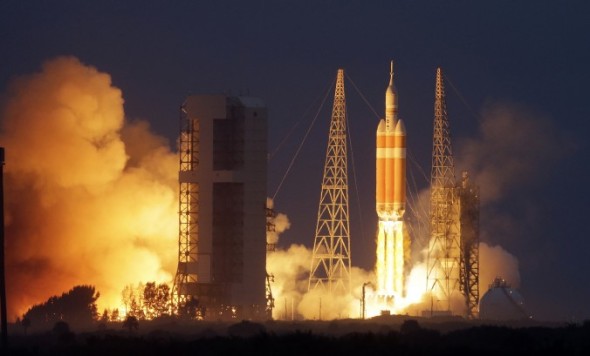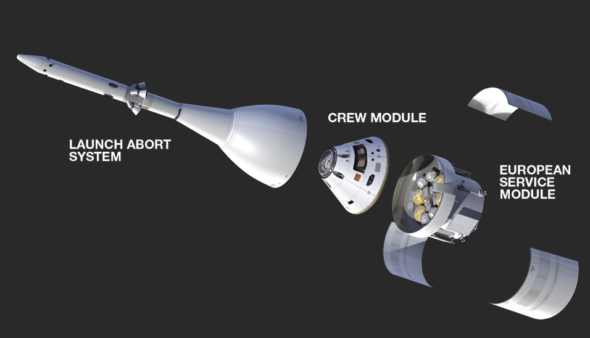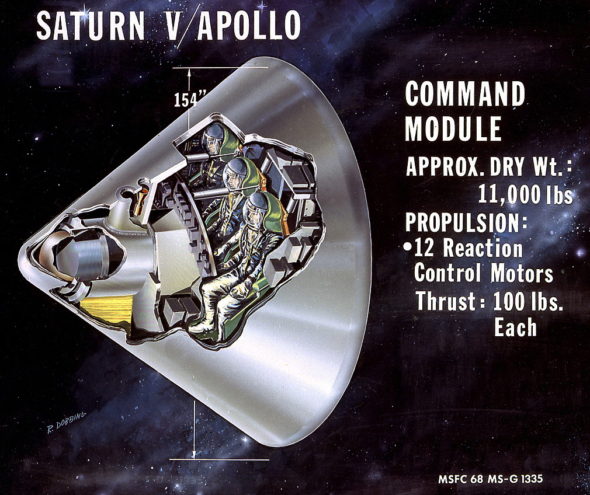redo Jump to...
print Print...
 (by Pete Spotts, The Christian Science Monitor) – NASA’s newest spacecraft for carrying humans beyond low-Earth orbit passed its initial flight test…following a spectacular launch from the Cape Canaveral Air Force Station Friday morning.
(by Pete Spotts, The Christian Science Monitor) – NASA’s newest spacecraft for carrying humans beyond low-Earth orbit passed its initial flight test…following a spectacular launch from the Cape Canaveral Air Force Station Friday morning.
Nearly 4-1/2 hours later, three enormous parachutes set the capsule into the Pacific Ocean some 275 miles west of Baja California and 630 miles southwest of San Diego – within 1-1/2 miles of the landing spot mission planners had projected prior to launch.
The mission represents the first test flight for Orion, the first craft that the National Aeronautics and Space Administration (NASA) has designed to carry crews to multiple destinations beyond low-Earth orbit, ultimately including Mars. The craft, along with a European-built service module, is in effect the cockpit and crew quarters for NASA’s space launch system for deep-space exploration. That system includes a new rocket that when finished will be the most powerful launch vehicle that humans have ever [launched].

Orion is also going to be attached to a single-use service module, built by the European Space Agency, that’ll provide power, propulsion, water, oxygen, extra cargo room, and other services to the capsule. NASA.
The Orion is the first craft designed to carry humans to leave low-Earth orbit since the Apollo program’s final trip to the moon in December 1972.
Current plans call for launching a second unmanned Orion capsule, along with the service module, atop the new rocket for a test of the system as a whole in late 2017 or 2018. That would carry the craft beyond the moon and back. A crewed mission would launch in 2021, either to a small asteroid if NASA has snagged one and brought it into lunar orbit by then, or to orbit the moon and return if no asteroid is at hand. …..
During Orion’s flight, the craft performed flawlessly, mission controllers reported, with a small handful of minor twitches.
One of the three video cameras aboard Orion returned images that lacked the expected clarity. On splashdown, only two or three of five air bags atop the capsule inflated. The air bags are designed to set the capsule upright in case it splashes down at an odd angle rather than directly on its heat shield. And the recovery crews were able to recover only two of the three main parachutes and none of the drogue or pilot parachutes that preceded deployment of the main ‘chutes.
Given the test objectives for the mission, these were minor inconveniences in an otherwise smooth test flight.
“We had a couple of very key test objectives very early in the flight, within the first six minutes,” said NASA’s program manager for Orion, Mark Geyer, as the mission progressed.
The craft successfully shed protective covers, or fairings, that enshrouded the structure standing in for the craft’s service module. And Orion successfully shed its launch-abort system – designed to speed the capsule away from a malfunctioning rocket during launch and ascent.
“Both of those were huge for us,” he said, in no small part because the ability to jettison them when no longer needed reduced Orion’s weight, making it easier for the Delta rocket’s second stage to propel the craft to an altitude of 3,600 miles on its second and final orbit.
After leaving low-Earth orbit and beginning its return, Orion also successfully separated from the service module and the second stage – another crucial test of the system.
In addition to putting the heat shield and the full reentry system through their paces, the mission also aimed to test Orion’s resistance to radiation in space as it passed twice through one of two radiation-intense regions known as the Van Allen radiation belts. Earth’s magnetic field helps shield craft in low-Earth orbit from cosmic rays or intense bursts or charged particles from the sun. Beyond low-Earth orbit, it’s every craft for itself.
The concern: Today’s computer chips are so densely crammed with components and connections that they present an easier target for random charged particles flitting through the craft than did older, less densely packed chips. Yet these newer chips rest at the heart of Orion’s onboard computers, as well as its navigation and flight-control systems. With a radiation sensor on board, engineers will be able to gauge the level of radiation that reached the craft’s interior. And they will be checking to see how extensively radiation affected the craft’s electronics – and if it did, how well the on-board systems recovered.
If Orion’s performance along the way is any indication, the craft’s electronics held up well. Each step of the programmed test process occurred as planned and on schedule, and Orion demonstrated controlled precision in following its planned reentry path to nail its splashdown point.
Reprinted here for educational purposes only. May not be reproduced on other websites without permission from The Christian Science Monitor. Visit the website at csmonitor .com.
Questions
NOTE TO STUDENTS: Before answering the questions, read “Background” under the questions and watch the videos under “Resources.”
1. What is Orion?
2. What is significant about Friday’s flight?
3. a) What is next for the program?
b) When (and where to) will a manned mission launch?
4. What glitches did the flight encounter?
5. Describe the test objectives that were successful.
6. How would you describe the tone of this news report?
CHALLENGE QUESTION: Sometimes a reporter will include his/her opinion in an otherwise factual news story (subjective comments about objective facts).
a) Identify the sentence which is the reporter’s opinion.
b) Do you think reporters should/could always refrain from including personal opinion into a news story? Explain your answer.
Background
After the Apollo mission to the moon ended in 1974, NASA relied on the Space Shuttle to carry its astronauts to and from the International Space Station (ISS), and occasionally the Hubble space telescope. These missions were the entirety of NASA’s crewed space activities. But NASA was always hoping to get back into outer space.
 The difference between putting astronauts in low-Earth orbit (where the ISS [International Space Station] is) and deep space (such as the moon or Mars) is akin to the difference between sailing along the coast and crossing the ocean. The ISS orbits just 268 miles above Earth — a bit more than the distance from New York to Washington, DC. The moon is about 239,000 miles away — roughly 10 times around the Earth’s equator.
The difference between putting astronauts in low-Earth orbit (where the ISS [International Space Station] is) and deep space (such as the moon or Mars) is akin to the difference between sailing along the coast and crossing the ocean. The ISS orbits just 268 miles above Earth — a bit more than the distance from New York to Washington, DC. The moon is about 239,000 miles away — roughly 10 times around the Earth’s equator.
So, in 2004, President Bush announced the Constellation Program: a plan to develop a new spacecraft system to carry astronauts to the moon by 2020 — and perhaps even Mars thereafter. Meanwhile, with the Space Shuttle due to be retired in 2011, NASA would contract with private companies to take over the now-routine ISS missions. (Delays have forced NASA to rely on Russia for these flights, but SpaceX and Boeing both hope to have vehicles ready by 2017.)
The Constellation project, however, quickly fell behind schedule for a few different reasons, including budget cuts. In 2010, President Obama cancelled it, replacing it with a new plan that included the same crewed capsule (Orion) and a single rocket system to launch both astronauts and cargo to new destinations.
After years of development, the Orion capsule is now ready for an initial test flight — albeit atop an older rocket, introduced a decade ago, rather than the new one. The next uncrewed test, currently scheduled for late 2017, will be the first one with the new rocket.
Orion most closely resembles the Apollo spacecraft used for missions to the moon in the 1960s and 1970s: it’s a small, cone-shaped capsule launched atop a single-use rocket.
Orion does have some upgrades, however: It’s 50 percent larger by volume (so it can carry 4 to 6 people, rather than 3), and contains much more sophisticated computer systems. It’s also intended to support astronauts for a much longer-term trip — roughly 21 days, which could be supplemented by an additional module for the 6-12 months it would take to get to Mars.
Resources
Visit NASA’s Orion page: nasa.gov/exploration/systems/orion/index.html
Read about Orion’s service module at wikipedia.
Watch a CBS News-Miami report:
Watch a USA Today report:
Daily “Answers” emails are provided for Daily News Articles, Tuesday’s World Events and Friday’s News Quiz.



